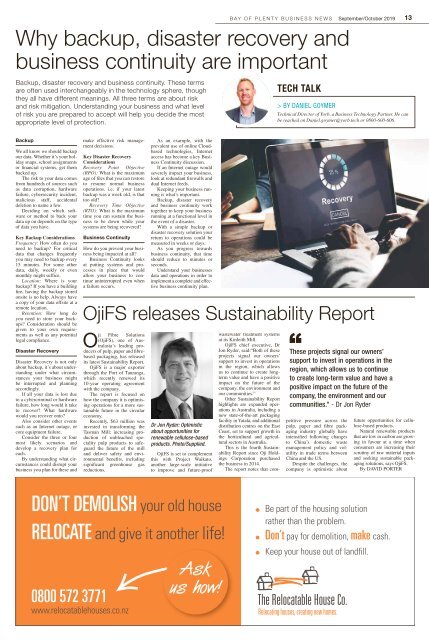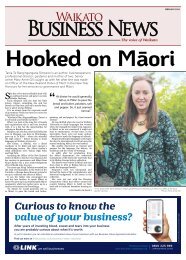Bay of Plenty Business News September/October 2019
From mid-2016 Bay of Plenty businesses have a new voice, Bay of Plenty Business News. This new publication reflects the region’s growth and importance as part of the wider central North Island economy.
From mid-2016 Bay of Plenty businesses have a new voice, Bay of Plenty Business News. This new publication reflects the region’s growth and importance as part of the wider central North Island economy.
Create successful ePaper yourself
Turn your PDF publications into a flip-book with our unique Google optimized e-Paper software.
BAY OF PLENTY BUSINESS NEWS <strong>September</strong>/<strong>October</strong> <strong>2019</strong><br />
13<br />
Why backup, disaster recovery and<br />
business continuity are important<br />
Backup, disaster recovery and business continuity. These terms<br />
are <strong>of</strong>ten used interchangeably in the technology sphere, though<br />
they all have different meanings. All three terms are about risk<br />
and risk mitigation. Understanding your business and what level<br />
<strong>of</strong> risk you are prepared to accept will help you decide the most<br />
appropriate level <strong>of</strong> protection.<br />
TECH TALK<br />
> BY DANIEL GOYMER<br />
Technical Director <strong>of</strong> Yorb, a <strong>Business</strong> Technology Partner. He can<br />
be reached on Daniel.goymer@yorb.tech or 0800-600-606.<br />
Backup<br />
We all know we should backup<br />
our data. Whether it’s your holiday<br />
snaps, school assignments<br />
or financial systems, get them<br />
backed up.<br />
The risk to your data comes<br />
from hundreds <strong>of</strong> sources such<br />
as data corruption, hardware<br />
failure, cybersecurity incident,<br />
malicious staff, accidental<br />
deletion to name a few.<br />
Deciding on which s<strong>of</strong>tware<br />
or method to back your<br />
data up on depends on the type<br />
<strong>of</strong> data you have.<br />
Key Backup Considerations<br />
Frequency: How <strong>of</strong>ten do you<br />
need to backup? For critical<br />
data that changes frequently<br />
you may need to backup every<br />
15 minutes. For some other<br />
data, daily, weekly or even<br />
monthly might suffice.<br />
Location: Where is your<br />
backup? If you have a building<br />
fire, having the backup stored<br />
onsite is no help. Always have<br />
a copy <strong>of</strong> your data <strong>of</strong>fsite at a<br />
remote location.<br />
Retention: How long do<br />
you need to store your backups?<br />
Consideration should be<br />
given to your own requirements<br />
as well as any potential<br />
legal compliance.<br />
Disaster Recovery<br />
Disaster Recovery is not only<br />
about backup, it’s about understanding<br />
under what circumstances<br />
your business might<br />
be interrupted and planning<br />
accordingly.<br />
If all your data is lost due<br />
to a cybercriminal or hardware<br />
failure, how long would it take<br />
to recover? What hardware<br />
would you recover onto?<br />
Also consider other events<br />
such as an Internet outage, or<br />
core equipment failure.<br />
Consider the three or four<br />
most likely scenarios and<br />
develop a recovery plan for<br />
each.<br />
By understanding what circumstances<br />
could disrupt your<br />
business you plan for these and<br />
make effective risk management<br />
decisions.<br />
Key Disaster Recovery<br />
Considerations<br />
Recovery Point Objective<br />
(RPO): What is the maximum<br />
age <strong>of</strong> files that you can restore<br />
to resume normal business<br />
operations. i.e. if your latest<br />
backup was a week old, is that<br />
too old?<br />
Recovery Time Objective<br />
(RTO): What is the maximum<br />
time you can sustain the business<br />
to be down while your<br />
systems are being recovered?<br />
<strong>Business</strong> Continuity<br />
How do you prevent your business<br />
being impacted at all?<br />
<strong>Business</strong> Continuity looks<br />
at putting systems and processes<br />
in place that would<br />
allow your business to continue<br />
uninterrupted even when<br />
a failure occurs.<br />
As an example, with the<br />
prevalent use <strong>of</strong> online Cloudbased<br />
technologies, Internet<br />
access has become a key <strong>Business</strong><br />
Continuity discussion.<br />
If an Internet outage would<br />
severely impact your business,<br />
look at redundant firewalls and<br />
dual Internet feeds.<br />
Keeping your business running<br />
is what’s important.<br />
Backup, disaster recovery<br />
and business continuity work<br />
together to keep your business<br />
running at a functional level in<br />
the event <strong>of</strong> a disaster.<br />
With a simple backup or<br />
disaster recovery solution your<br />
return to operations could be<br />
measured in weeks or days.<br />
As you progress towards<br />
business continuity, that time<br />
should reduce to minutes or<br />
seconds.<br />
Understand your businesses<br />
data and operations in order to<br />
implement a complete and effective<br />
business continuity plan.<br />
OjiFS releases Sustainability Report<br />
Oji Fibre Solutions<br />
(OjiFS), one <strong>of</strong> Australasia’s<br />
leading producers<br />
<strong>of</strong> pulp, paper and fibrebased<br />
packaging, has released<br />
its latest Sustainability Report.<br />
OjiFS is a major exporter<br />
through the Port <strong>of</strong> Tauranga,<br />
which recently renewed its<br />
10-year operating agreement<br />
with the company.<br />
The report is focused on<br />
how the company it is optimising<br />
operations for a more sustainable<br />
future in the circular<br />
economy.<br />
Recently, $63 million was<br />
invested in transforming the<br />
Tasman Mill; increasing production<br />
<strong>of</strong> unbleached speciality<br />
pulp products to safeguard<br />
the future <strong>of</strong> the mill<br />
and deliver safety and environmental<br />
benefits, including<br />
significant greenhouse gas<br />
reductions.<br />
Dr Jon Ryder: Optimistic<br />
about opportunities for<br />
renewable cellulose-based<br />
products. Photo/Supplied.<br />
OjiFS is set to complement<br />
this with Project Waikato,<br />
another large-scale initiative<br />
to improve and future-pro<strong>of</strong><br />
These projects signal our owners’<br />
support to invest in operations in the<br />
region, which allows us to continue<br />
to create long-term value and have a<br />
positive impact on the future <strong>of</strong> the<br />
company, the environment and our<br />
communities.” - Dr Jon Ryder<br />
wastewater treatment systems<br />
at its Kinleith Mill.<br />
OjiFS chief executive, Dr<br />
Jon Ryder, said:“Both <strong>of</strong> these<br />
projects signal our owners’<br />
support to invest in operations<br />
in the region, which allows<br />
us to continue to create longterm<br />
value and have a positive<br />
impact on the future <strong>of</strong> the<br />
company, the environment and<br />
our communities.”<br />
Other Sustainability Report<br />
highlights are expanded operations<br />
in Australia, including a<br />
new state-<strong>of</strong>-the-art packaging<br />
facility in Yatala, and additional<br />
distribution centres on the East<br />
Coast, set to support growth in<br />
the horticultural and agricultural<br />
sectors in Australia.<br />
This is the fourth Sustainability<br />
Report since Oji Holdings<br />
Corporation purchased<br />
the business in 2014.<br />
The report notes that competitive<br />
pressure across the<br />
pulp, paper and fibre packaging<br />
industry globally have<br />
intensified following changes<br />
to China’s domestic waste<br />
management policy and volatility<br />
in trade terms between<br />
China and the US.<br />
Despite the challenges, the<br />
company is optimistic about<br />
future opportunities for cellulose-based<br />
products.<br />
Natural renewable products<br />
that are low in carbon are growing<br />
in favour at a time when<br />
consumers are increasing their<br />
scrutiny <strong>of</strong> raw material inputs<br />
and seeking sustainable packaging<br />
solutions, says OjiFS.<br />
By DAVID PORTER<br />
DON’T DEMOLISH your old house<br />
RELOCATE and give it another life!<br />
0800 572 3771<br />
www.relocatablehouses.co.nz<br />
Ask<br />
us how!<br />
Be part <strong>of</strong> the housing solution<br />
rather than the problem.<br />
Don’t pay for demolition, make cash.<br />
Keep your house out <strong>of</strong> landfill.


















